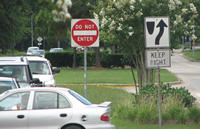
Signs - Traffic Control Devices
According to the U.S. Department of Transportation Federal Highway Administration: Safety is up to you. Designing highways with signs signals and markings can only do so much to ensure safety. But in the end, safety is the responsibility of every driver.
Safety is the goal of all the signs, signals and roadway markings discussed in this lesson. It is essential that drivers cooperate when lane changing, merging, exiting, turning and many other situations they come across. We must all share the road and cooperating is one of the main keys to safety.

What's wrong with this picture?
For your safety and the safety of others, "read" what all traffic control devices - road signs, signals, and pavement markings - are telling you. They have been placed there for a reason: to help you more safely share the road and stay alive! Now lets get to the signs, signals and roadway markings that all drivers need to get around town or the nation.
Signs and Safety
Road signs and safety are essential elements of safe and successful driving. Knowing how to read and interpret road signs is one of the most important skills you can develop as a driver. Road signs are designed to warn drivers of hazards, give directions, inform drivers of the rules of the road, and provide other helpful information. In order to drive safely, it is important to pay attention to road signs and obey them.
Road signs come in a variety of shapes and sizes, and can be divided into four main categories: regulatory signs, warning signs, guide signs, and special purpose signs. Regulatory signs are used to inform drivers of laws and regulations that must be followed. Examples of regulatory signs include speed limit signs, stop signs, one-way signs, and yield signs. Warning signs are used to alert drivers to potential hazards such as sharp curves, steep grades, railroad crossings, and animal crossings. Guide signs are used to provide drivers with information about destinations, distances to points of interest, parking, and special services. Special purpose signs are used to provide directions for construction zones, detours, and other special events.
No matter what type of sign you encounter, it is important to pay attention to it and obey the instructions it provides. For example, when you see a speed limit sign, you must reduce your speed to the posted limit. When you see a stop sign, you must come to a complete stop before proceeding. When you see a yield sign, you must slow down and give the right-of-way to other vehicles.
In addition to following the instructions provided by road signs, there are other safety tips you should follow when driving. Make sure to always wear your seatbelt, drive at a safe speed, and keep your eyes on the road. It is also important to be aware of changing road conditions, such as weather or traffic. Finally, it is important to keep your vehicle well-maintained to ensure that it is running safely and efficiently.
By following the instructions provided by road signs and practicing safe driving habits, you can ensure that you are driving safely and responsibly. It is important to remember that road signs are there to help keep you safe, so always pay attention to them and obey their instructions. Doing so will help you to become a better and safer driver.















